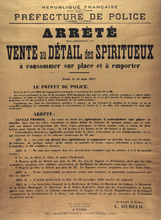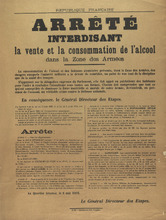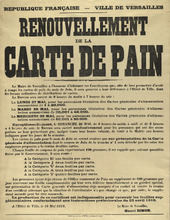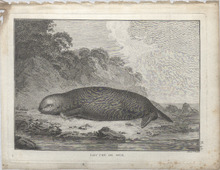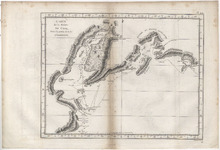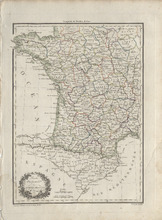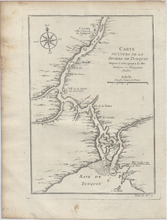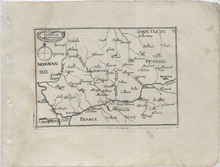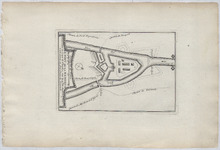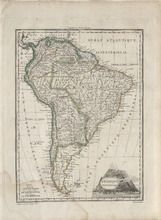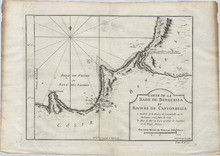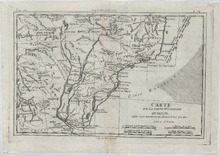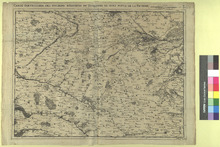Detailed single page historical copper engraved map of Scotland. The map shows several geographic details on cities, towns, rivers, lakes, reliefs, and islands. The vignette title is an engraved view of basalt columns. Regions appearing on this map include: Scotland: Kirkcudbright (Kirkcudbrightshire or Dumfries and Galloway), Wigton (Wigtownshire or Dumfries and Galloway), Berwick (Berwickshire or Scottish Borders), Haddington (Haddingtonshire or East Lothian), Roxburgh (Roxburghshire or Scottish Borders), Edimburgh (City of Edinburgh, Midlothian, and West Lothian), Peebles (Peeblesshire and Scottish Borders), Selkirk (Selkirkshire or Scottish Borders), Dumfries (Dumfriesshire or Dumfries and Galloway), Ayr (Ayrshire or North Ayrshire, East Ayrshire, and South Ayrshire), Linlitgow (Linlithgowshire or West Lothian), Lanerk (Lanarkshire or East Dunbartonshire, Glasgow City Council, North Lanarkshire, and South Lanarkshire), Renfrew (Renfrewshire or Renfrewshire, East Renfrewshire, and Inverclyde), Dunbarton (Dunbartonshire or East Dunbartonshire and West Dunbartonshire), Argyle (Argyll or Argyll and Bute), Kincardine (Kincardineshire or Aberdeenshire), Angus (Angus and Dundee City), Aberdeen (Aberdeenshire), Perth (Perthshire or Clackmannanshire, Perth and Kinross, and Stirling), Kinross (Kinross-shire or Perth and Kinross), Clackmannan (Clackmannanshire), Stirling (Stirlingshire or Stirling, East Dunbartonshire, Falkirk, and North Lanarkshire), Inverness (Inverness-shire or Inverness), Aberdeen (Aberdeenshire), Ross (Ross-shire or Highland), Southerland (Highland), Caithness (Highland), Orkney Islands, and the Shetland Islands. Cities appearing on this map include: England: Hartlepool, Durham, Shields (South Shields), Newcastle (Newcastle upon Tyne), Hexham, Applebi (Appleby-in-Westmorland), Carlisle, Workington, Morpeth, Bellingham, Rothbury, Alnwick, Bedford (Belford), Berwick (Berwick-upon-Tweed), and Longtown. Scotland: Cities in the Kirkcudbright region (Kirkcudbrightshire or Dumfries and Galloway): Kirkcudbright, Castle Douglas, New Galloway, Gleneard (?), and Boidnock (?). Cities in the Wigton region (Wigtownshire or Dumfries and Galloway): Wigton (Wigtown), Whitehorn (Whithorn), Glenluce, Stranrawer (Stranraer), Kirkbride (Kirkmaiden), Pt. Patrick (Portpatrick), Newton Stewart, and Kirkcolm. Cities in Berwick region (Berwickshire or Scottish Borders): Eyemouth, Cockburnspath, Buncle (Bonkyll Castle), Dunse (Duns), Greenlaw, Coldstream, Channel (Channelkirk), and Lauder. Cities in Haddington region (Haddingtonshire or East Lothian): Haddington and Dunbar Cities in Roxburgh region (Roxburghshire or Scottish Borders): Kelso, Jedburgh, Hawick, Peel (?), and Park (?). Cities in Edimburgh region (City of Edinburgh, Midlothian, and West Lothian): Leith, Edimburgh (Edinburgh), Mid Calder, Whiteburn (Whitburn), Howgate, and Falla (?). Cities in Peebles region (Peeblesshire and Scottish Borders): Linton (West Linton), Peebles, Glenholme (?), and Elveedfout (Elvanfoot). Cities in Selkirk region (Selkirkshire or Scottish Borders): Galashiels, Melrose, and Selkirk. Cities in Dumfries region (Dumfriesshire or Dumfries and Galloway): Longholm (Langholm), Annan, Ecclesfechan (Ecclefechan), Dumfries, Bounby (?), Lochmeben (Lochmaben), Eskdalemoor (Eskdalemuir), Moffat, Monyhive (Moniaive), and Sanquar (Sanquhar). Cities in Ayr region (Ayrshire or North Ayrshire, East Ayrshire, and South Ayrshire): Ballantrae, Gaighead (?), Girvan, Maybole, Cumnock, Muirkirk, Derval (Darvel), Ayr, Kilmarnock, Irvine, Dalry, Beith, Kelly (?), Corry (Corrie), and Dippin. Cities in Linlitgow region (Linlithgowshire or West Lothian): Linlithgow Cities in Lanerk region (Lanarkshire or East Dunbartonshire, Glasgow City Council, North Lanarkshire, and South Lanarkshire): Biggar, Douglass (Douglas), Strathaven, Lanerk (Lanark), Airdrie, Kilbride (East Kilbride), Hamilton, and Glascow (Glasgow) Cities in Renfrew region (Renfrewshire or Renfrewshire, East Renfrewshire, and Inverclyde): Paisley Cities in Dumbarton region (Dunbartonshire or East Dunbartonshire and West Dunbartonshire): Dumbarton Cities in Argyle region (Argyll or Argyll and Bute): Kilmodan (Kilmun), Calves (?), Inverniel (Inverneil), Tarbet (Tarbert), Campbelton (Campbeltown), Fernach (?), Jara (Jura), Ardmore, Killaraw (?), Cule (?), Inverary (Inveraray), Minart (Minard), Inishall (?), Dalmaly (Dalmally), Bunawe (Bonawe), Inveruchisar (?), Kenlochliven (?), Kinlock Etive (?), Gleniure (?), Kiell (?), Oban, Charseg (Carsaig), Staffa Bourg (?), Liderkill (?), Raho (Rahoy), Strontian (?), Kilmory, and Waal (Vaul). Cities in Kincardine region (Kincardineshire or Aberdeenshire): Pt. Lethen (Portlethen), Stonehaven, Glenbervie (?), Bervie (Inverbervie), and St. Cyrus. Cities in Angus region (Angus and Dundee City): Montrose, Berchine (Brechin), Forfar, Aberbrothock (Arbroath), Dundee, Gortachy (?), and Glentinineant (?). Cities in Aberdeen region (Aberdeenshire): Wells (?), Troup (?), Aberdour (New Aberdour), Fraserburgh, S. Fergus (St. Fergus), Turreff (Turriff), Deer (New Deer), Peterhead, Slains (Slains Castle), Ellon, Rothie (Rothienorman), Huntley (Huntly), Rain (Old Rayne), Meldrum (Oldmeldrum), Inverurie, Dalreoch (?), Belhelvie, Kintore, Aberdeen, Banchory, Kincardine (Kincardine O'Neil), Crathy (Crathie), Corgarf (Corgarff), Newton (?), and Allanmore (?). Cities in Perth region (Perthshire or Clackmannanshire, Perth and Kinross, and Stirling): Crail, St. Andrews, Largo (Upper Largo), Dysert (Dysart), Bruntisland (Burntisland), Auchurmuchty (Auchtermuchty), Dunning, Perth, Errol, Coupar (Coupar Angus), Blairgourie (Blairgowrie and Rattray), Dunkeld, Dalmunzie (?), Bodenluig (Ballinluig), Blackford, Crieff, Dumblain (Dunblane), Doune, Altarnin (?), Crienlirch (Crianlarich), Killin, Kenmoor (Kenmore), Aberfeldie (Aberfeldy), Blair Atholl, and Dalnacardoch (?). Cities in Kinross region (Kinross-shire or Perth and Kinross): Kinross. Cities in Stirling region (Stirlingshire or Stirling, East Dunbartonshire, Falkirk, and North Lanarkshire): Stirling, Killsyth (Kilsyth), and Drymen. Cities in Inverness region (Inverness-shire or Inverness): Dalwhinnie, Letter Findlay (?), Ft. William, Glenfinnan, Aylort (?), Granton (Grantown-on-Spey), Rothemarchus (Rothiemurchus), Pitmain (Pitmain Farms), Batleloin (?), Doondarduit (?), Kilmare (Kilmore), Polmally (Polmaily Wood), Dores, Inverness, Deamy (?), Comer (?), Giusachan (Guisachan Forrest), Dundreggan, Reabuie (?), Arnalish (?), Sorath (?), Torin (?), Kinloch, Dunan (?), Housedale (?), Penmore (Peinmore House), Ilamar (?), Boisdale, and Peninaurin (?). Cities in Banff region (Banffshire or Moray and Aberdeenshire): Banff, Portsoy, Cullen, Port Nockie (Portnockie), Fochabers, Keith, Boharn (Botarm), Inveraven (Inveraven Church), Candlemore (?), and Gaulrig (?). Cities in Murray region (Elginshire or Moray): Elgin, Forres, and Kincardine (?). Cities in Nairn region (Inverness): Nairn. Cities in Ross region (Ross-shire or Highland): Kinloch Ailsh (?), Ardmore, Tain, Assint (?), Auchindrick (?), Cromarty, Fortrose, Dingwall, Munlochy, Beauley (Beauly), Dormy (?), Ardeyere (?), Stron (Strone Wood), Cowes (Cove), Inverew (Inverewe Garden & Estate), Tagin (Taagan), Ripuch (?), Achnaskin (?), Ballachnaeraw (?), Gallackin (?), Aremean (?), Brenlish, Keriwick, Barvas, and Gulson (Galson Farm). Cities in Southerland region (Highland): Helmsdale, Loth (Lothmore), Brora, Golspie, Dornocft (Dornoch), Invershin (?), Sinsesh (Shinness Lodge), Killernan (?), Dubol (?), Trontite (Trantlemore), Grubmore (Grummore), Tongue, Armsdale (Armadale), Strathbeg (?), Kerwick (?), Glendue (?), and Ballawotin (?). Cities in Caithness region (Highland): Berrydale (?), Dunbeath, Nottingham, Mid Clyth, Wick, Orem (?), Thurso, Brims (?), and Houna (Huna). Cities in Orkney Islands: Kirkwald (Kirkwall) and Sandwick. Northern Ireland: Belfast, Glenarm, and Coleraine. Ireland: Killybegs Source publication: Atlas Complet Du Precis De la Geographie Universelle De M. Malte Brun dressee par M. Lapie Capitaine Ingenieur Geographie Pierre M. Lapie (1779-1850) and his son Alexandre Emile Lapie (1809-1850) were French cartographers and engravers active in the early part of the 19th Century. The Lapies were commissioned officers in the French army holding the ranks of Colonel and Capitaine, respectively. Alexander enjoyed the title of "First Geographer to the King", and this title appears on several of his atlases. Both father and son were exceptional engraversand fastidious cartographers. Working separately and jointly they published four important atlases, an 1811 Atlas of the French Empire (Alexander), the 1812 Atlas Classique et Universel (Pierre), the Atlas Universel de Geographie Ancienne et Modern (joint issue), and the 1848 Atlas Militaire (Alexander). They also issued many smaller maps and independent issues. All of these are products of exceptional beauty and detail. Conrad Malte-Brun (1755-1826) was an important late 18th and early 19th Century Danish/French cartographer and revolutionary. Conrad was born in Thisted, Denmark. His parents encouraged him to a career in the Church, but he instead enrolled in the University of Copenhagen. In the liberal hall of academia Conrad became an ardent supporter of the French Revolution and the ideals of a free press. Despite the harsh censorship laws of crown prince Frederick VI, Malte-Brun published numerous pamphlets criticizing the Danish government. He was finally charged with defying censorship laws in 1799 and forced to flee to Sweden and ultimately France. Along with colleague Edme Mentelle, Malte-Brun published his first cartographic work, the Geographie mathematique, physique et politique de toutes les parties du monde (6 volumes published between 1803 and 1807). Conrad went on to found Les Annales des Voyages (in 1807) and Les Annales des Voyages, de la Geographie et de l'Histoire (in 1819). He also founded the Paris Societe de Geographie. In time, Conrad became known as one of the finest French cartographers of his time.
